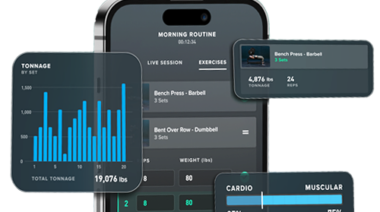Athletes dedicate their lives to achieving their full potential, or as close to it as possible. So why do so many of us — strength athletes especially — take shortcuts when it comes to recovery? That’s the question Will Ahmed, CEO and Founder of WHOOP, set out to address when he was still an undergraduate. WHOOP makes hardware and software to track recovery, performance, and sleep for athletes from the everyday to elite.
WHOOP built its brand working with pro athletes in leagues like the NBA and NFL (Kevin Durant is an investor), and now Will and his team have set out to help strength athletes quantify and better manage their recovery, working with athletes like multi-time CrossFit Games Champion Katrin Davidsdottir.

Take advantage of a free one-month trial of WHOOP, which includes full access to everything the app has to offer, along with a WHOOP 4.0 device.
(We receive free products to review and may receive a commission on items purchased through our links.)
The important thing to understand about strength athletes is that you actually don’t get stronger in the gym. Your body is breaking down in the gym and then it repairs itself, and that’s how you get stronger. The whole repairing process occurs primarily during sleep.
Will’s experience as a college athlete and researcher led to what many consider the most promising technology company in athletic recovery. But it didn’t happen overnight, and the challenges WHOOP helps strength athletes overcome have led to some particularly interesting revelations.
In this episode of The BarBend Podcast, guest Will Ahmed and host David Thomas Tao discuss:
- WHOOP’s origins and Will’s inspiration as a college athlete (2:20)
- The over-emphasis many athletes place on training — at the expense of recovery (5:00)
- How strength athletes are using WHOOP (8:52)
- Why so many fitness trackers have failed strength athletes (11:46)
- What Will wants strength athletes to get from WHOOP, and where there’s space to grow (15:52)
- Balancing sympathetic and parasympathetic divisions of the nervous system, and a quick test to feel the difference yourself (17:37)
- The impact of alcohol on training and recovery, and why it’s probably more pronounced than you think (19:29)
- Sleep tracking for performance (23:51)
- Will’s predictions for the next “big thing” in athletic recovery (27:46)
- The upcoming rebelling to technology addiction, and what that means for companies like WHOOP (29:46)
Relevant links and further reading:
- Follow Will Ahmed on Instagram
- Listen to the WHOOP Podcast on Apple Podcasts
- Read BarBend’s guide to HRV, written in collaboration with WHOOP
- Interested in WHOOP and want to save $30 on a membership? Use the code “BarBend” at checkout to save $30!